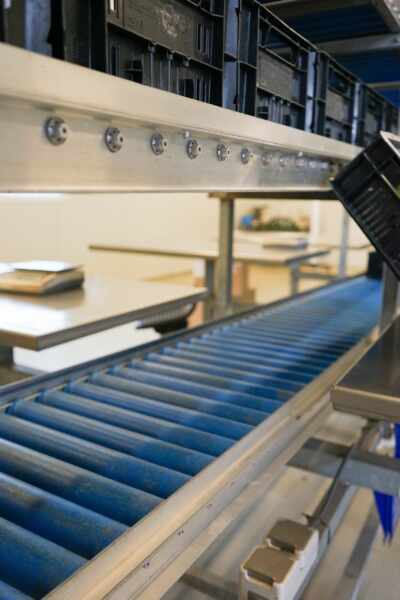In today’s competitive food manufacturing landscape, optimising energy efficiency is a crucial aspect of maintaining a profitable and environmentally responsible operation. One of the most significant energy consumers in any food manufacturing facility is conveyor belt systems, which play a vital role in material handling and transport throughout the production line. As the primary mode of product transportation, conveyor belts frequently run continuously, leading to significant energy consumption over time.
To address this issue, many food manufacturers are turning towards energy-saving conveyor belt systems designed to optimise energy usage while maintaining operational efficiency. Such systems incorporate innovative features, technologies, and design elements that minimise energy consumption, reduce operational costs, and contribute to a more sustainable food manufacturing process.
In this comprehensive guide, we will examine the benefits of implementing energy-efficient conveyor belt systems within food manufacturing facilities and explore a range of strategies for enhancing energy efficiency across your entire production process. We will discuss the valuable return on investment provided by energy-saving solutions and delve into the various design, material, and operational factors that contribute to a more energy-efficient conveyor belt system.
Embrace the power of innovation and sustainable practices to elevate your food manufacturing facility’s energy efficiency, reduce operational costs, and boost overall profitability.
Benefits of Energy-Efficient Conveyor Belt Systems
Implementing energy-efficient conveyor belt systems within your food manufacturing facility offers numerous advantages, including:
1. Cost Reductions: Optimising energy consumption reduces overall operational costs, improving your facility’s profitability and competitive edge in the market.
2. Sustainability & Environmental Responsibility: Energy-efficient solutions help minimise your facility’s environmental impact, contributing to a more sustainable food manufacturing process and promoting a positive brand image.
3. Compliance with Regulations: Energy efficiency regulations and initiatives are becoming increasingly prevalent throughout various industries. Implementing energy-saving technologies supports compliance with such regulations, protecting your facility from potential penalties and fines.
4. Enhanced Equipment Life: Energy-efficient conveyor belt systems often incorporate design features that reduce wear and tear on equipment components, extending the system’s lifespan and reducing maintenance costs.
Strategies for Enhancing Energy Efficiency
To improve energy efficiency in your food manufacturing facility, consider adopting the following strategies:
1. Assess Your Current System: Begin by evaluating your existing conveyor belt system to identify areas where energy consumption can be optimised. This process may include measuring energy usage, cataloguing equipment inefficiencies, and assessing the overall system design.
2. Optimise Conveyor System Design: Implement design modifications to streamline your conveyor belt system, minimising energy consumption by reducing unnecessary friction and resistance throughout the equipment. Efficient system design may include adjusting belt speeds, modifying the conveyor’s layout, and employing energy-saving drive systems.
3. Upgrade to Energy-Efficient Conveyor Belts: Switch to energy-efficient conveyor belts designed specifically to minimise energy consumption. These belts often include low-friction materials, lightweight construction, and innovative features that reduce energy usage.
4. Implement Variable Frequency Drives (VFDs): Utilising VFDs allows you to control the speed and torque of your conveyor belt motors, optimising energy usage by adjusting motor speed based on real-time production demands.
5. Regular Maintenance and Inspections: Conduct routine inspections and maintenance to ensure your conveyor belt system remains in optimal working condition. Maintaining equipment efficiency helps prevent energy waste and reduces the likelihood of costly breakdowns.
Key Factors to Consider for Energy-Efficient Conveyor Belt Systems
To create a more energy-efficient conveyor belt system in your food manufacturing facility, consider the following factors:
1. System Design: Analyse your conveyor belt system’s overall design and layout to identify areas where energy usage can be optimised. This may involve removing unnecessary bends or inclines, minimising belt length, and reconfiguring the system to reduce load and friction.
2. Material Selection: Opt for low-friction materials in your conveyor belt construction, as these materials can help reduce energy consumption by minimising resistance throughout the system.
3. Drive Configuration: Employ energy-efficient drive systems that promote efficient energy transfer to your conveyor belt system. Consider implementing direct drive technology, which eliminates the need for energy-wasting gears and pulleys.
4. Component Optimization: Update equipment components such as motors, drives, and bearings to more energy-efficient versions to further minimise energy consumption.
Conclusion
Adopting energy-efficient conveyor belt systems within your food manufacturing facility offers significant benefits, including reduced operational costs, enhanced profitability, and improved environmental sustainability. By assessing your current system, optimising system design, selecting energy-efficient materials and components, and maintaining regular inspections and maintenance, you can achieve a more energy-efficient and cost-effective production process.
Partnering with leading industry suppliers like Change Parts Pty Ltd can provide access to a wealth of expert guidance, tailored solutions, and premium-quality products designed to enhance energy efficiency across your entire food manufacturing operation.
Ready to boost energy efficiency in your food manufacturing facility and reduce operational costs with innovative, energy-saving conveyor belt systems? Contact Change Parts Pty Ltd today for expert advice, bespoke solutions, and top-tier products designed to meet your unique needs and facilitate a sustainable, profitable food production process.




